Traditional Japanese garden is considered one of the most important elements of Japanese art. Each type of traditional Japanese gardens has their own style of beauty.
In Japan, visiting a traditional garden is a must-do activity along with exploring beautiful landscape, castles, museums, temples and shrines. There is a list of historic Japanese gardens can be found across the country, especially in Kyoto (formal capital city of Japan) and Tokyo.
Kyoto is known for its historic temples and shrines that are mostly decorated with beautiful gardens. The landscapes of these gardens change frequently as the four seasons of Japan pass them by throughout a year.
There, visitors can experience picturesque view of colorful foliage in the fall, and an unforgettable sakura blossoms display in spring.

A large number of tourists want to explore at least some Japanese gardens that are located mostly in Kyoto and Tokyo. Have you ever visited any traditional Japanese garden yet?
Japanese garden is beautiful as traditional Chinese garden. Although Japanese were inspired by ancient Chinese style outdoor garden, sometimes I believe Japanese garden is far beautiful than the Chinese ones.
It represents the ultimate beauty of nature. Almost every Japanese garden symbolizes things. For example, sand or gravel symbolizes river, on the other hand, rocks represent the mountain.
Japanese Garden History
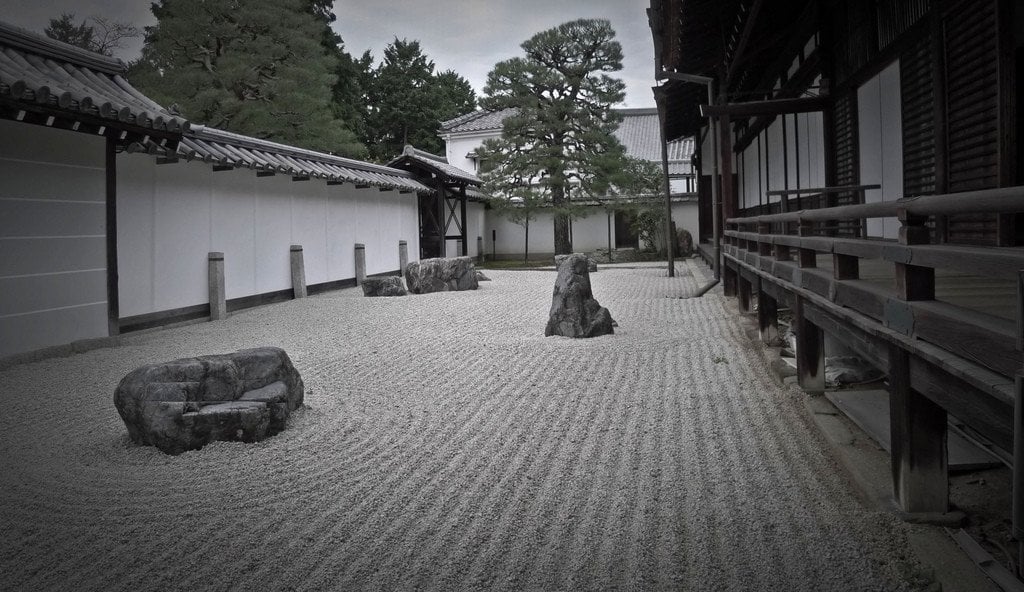
Japanese gardens that you find in the land of the rising sun, were not created yesterday. They have left so many years behind but still they shine like the old days.
Some of the Japanese gardens you see in Kyoto and Tokyo are truly great and most of them were built thousands years ago from now.
They represent a long period of history where you could experience both positive and negative view of them.
Many beautiful gardens were destroyed over times due to war and natural disasters, many were built in modern Japanese era and there are some that are being built by the great artists.
In Japan, many Japanese merchants during the Asuka period (538–710) used to visit its neighboring country China. They were influenced by the contemporary Chinese arts. The beauty of traditional style Chinese gardens inspired them to make their own.
It is said that between 630 and 838, along with Buddhist monks, Japanese court had sent scholars, diplomats, students, and translators to China. So the idea of these unique gardens developed around the 7th century when Buddhism first was introduced in Japan from China.

History indicates that Japanese garden was developed throughout different periods of time, such as in Asuka period, Nara period, Heian period, Kamakura & Muromachi periods, the Momoyama period, Edo period, Meiji period and Modern era.
You can notice the different styles of gardens that were designed and built from Asuka period to modern era once you visit a few gardens located in Kyoto and Tokyo.
The garden of the Askua and Nara periods were all destroyed in the past, now people can only find them in various paintings.
There is a type of Japanese garden called “Paradise Garden” – that was first developed in the Heian period (794-1185). A book called “The Sakuteiki” was written in this period and it was the first book ever written about garden making technique.

Zen Buddhism flourished during the Kamakura and Muromachi periods (1185-1573), as a result in many Zen Buddhist temples had built Zen Style Japanese Garden.
On the other hand, tea garden was introduced during the Momoyama period (1586-1600). This kind of garden is considered one of the most beautiful types of Japanese gardens in Japan.
During the Edo period (1615-1867), rock Zen gardens size became bigger than they were before in Kamakura and Muromachi periods.
The famous gardens that were created in the Meiji era (1868–1912) all were built under the supervision of many businessmen and politicians.
Today, in the 21st century you can even observe modern style Japanese garden that are distinct than those of the gardens styles you have been informed here earlier.
Elements of Japanese Garden

Japanese garden has been designated as a place of peacefulness. In fact, it was one of the reasons why Zen garden making idea came in to mind of Zen Buddhist monks.
Buddhism teaches us to be peaceful and this doctrine gives us a clear view of how decorative and calm Zen garden could be just by using sand or gravel.
These two elements represent the water. And when you take a look at one of these types of gardens you find peace there. It’s obvious that a state of being calm and quiet come from a Zen garden.
There are other important elements that represent various things we find in our nature, they are water, sand, gravel, stone, rock, island, hills, teahouse, bridge, stream, fishes, strolling path, stone-lantern, bamboo pipe, moss, flowers, pond, trees, statues, gates, water basin, and garden fences.
Every element has different meanings and they symbolize many important things.
Water or pond is seen to be one of the vital elements of Japanese garden except Zen gardens. Whereas sand or gravel of a rock and zen garden’s represents water, clouds and purity.
Japanese bridges that you see in Japanese gardens reflect artistic feelings. Small ponds represent the ocean or sea while fishes are used as part of decorative element.
A stone lantern represents the four natural elements: fire, water, earth and wind. Every element that are shown above used to decorate or making one garden more appalling.
Types of Japanese Garden
Traditionally, there are three main styles of Japanese gardens. These three different types gardens are known as Karesansui, Tsukiyama, Chaniwa representing different meaning based on their style of looking.
In this post, we would get familiar with other types of Japanese gardens that are truly profound.
Karesansui (Rock/Dry/Zen Garden):

It represents the spiritualism of Zen Buddhism. It was formed by a Zen Buddhist monk called Musō Soseki.
Instead of using water in this type of garden, sand or gravel is used to represent river or sea. Simply a peaceful garden like this would amaze you and let you know the real beauty of Japanese garden.
You have no idea how artistic they were during the Kamakura and Muromachi periods. One of the main elements for Zen garden is boulders that come in various shapes and sizes.
A single boulder represents an inland which looks absolutely stunning with those shrubs and small trees planted nearby.
Various techniques are employed in designing a successful Zen garden. A Zen garden usually provides enough space and great atmosphere to do meditation and yoga while sitting at its observatory.
Tsukiyama (Hill and Pond Garden):
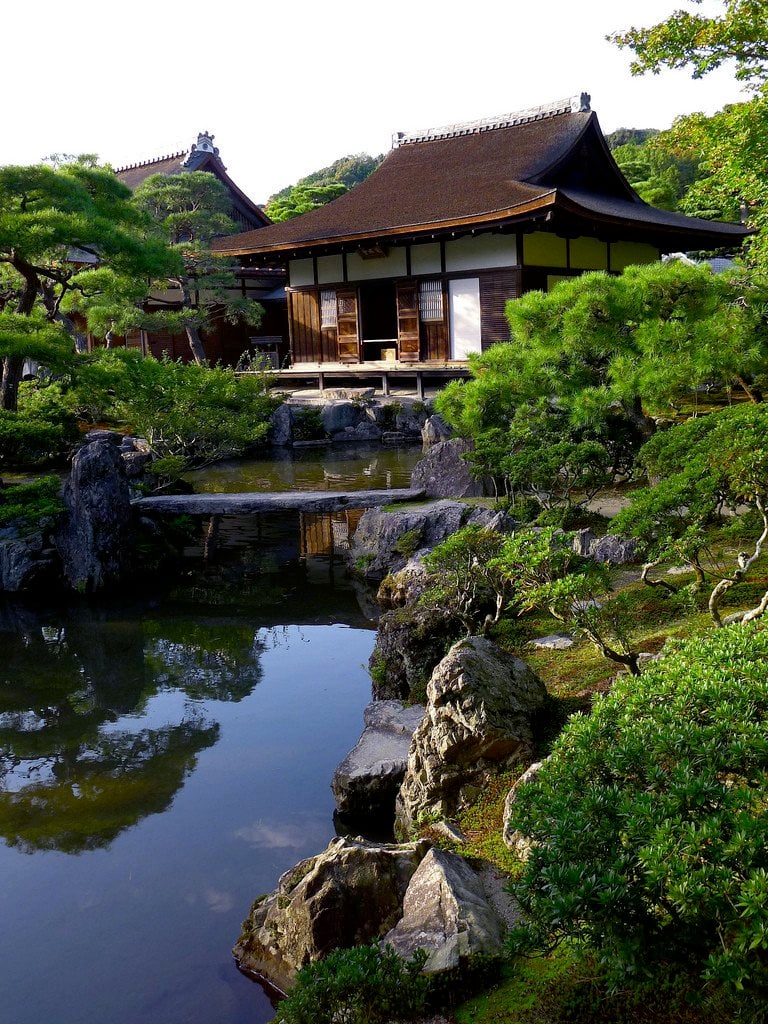
This Japanese style garden represents a miniature of natural scenery that includes ponds, hills, stones, trees, fishes, bridges, moss, paths, flowers, small plants and streams.
In fact, you would like to compare the beauty of Hill garden and Zen garden while both of them are quite distinctive and have spiritual connection.
The word Tsukiyama refers to the creation of artificial or manmade hills. This is a classic style of Japanese garden that can be enjoyed while taking a stroll along the garden paths and from temple’s veranda.
In general, a hill garden becomes bigger than a Zen garden, though it is possible to create one even in a small area applying gardening techniques.
Many tourists visit this traditional style garden in spring and fall season. The only reason behind this is they can witness a lot of cherry blossoms, and gorgeous red maple leaves.
If you are really excited about visiting this style Japanese garden, pay a visit to Ginkaku-ji/Silver Pavilion in Kyoto.
Chaniwa (Tea Garden):

Tea garden is a type of beautiful Japanese garden that has a tea ceremony house along with the garden. This garden can be categorized into two sections: inner garden and outer garden.
The outer garden follows a path which would lead to reach to its inner garden. Both inner and outer gardens are separated by covered gate.
It is a custom to wash your hands before entering into the inner garden. You can wash your hands from the stone water basin (tsukubai) that is placed in the garden. In general, Zen garden is small in size comparing to Tsukiyama and Karesansui.
You will encounter this type of Japanese garden when you decide to go to a tea ceremony.
The main features of this type of garden are Ishidoro (a small stone lantern), Tsukubai (A stone basin where guests can wash their hands), Nakakuguri (a middle gate), Tobi-ishi (stepping stones) and Kakei (a bamboo pipe through which water flows constantly).
Stroll Garden:

Stroll garden originally was developed in the Edo period, since then it has become one of the most beautiful styles of gardens that we see throughout Japan.
There is no inner or outer garden can be found here but a path which is made only for a leisurely stroll. You are to follow a clockwise direction when you start walking through the path.
It features a small central lake and pond with a path going around it. Two elements: boulders and trees could add extra beauty to this garden and usually they are featured, and you can witness this in Suizenji Park, Kumamoto.
One of the advantages to this style of garden is – you have an opportunity to reveal the whole garden beauty from different directions.
Japanese Paradise Garden:

During the Heian Period, Japanese paradise gardens were first introduced in Japan by the devotees of Amida sect and Buddhist monks.
This kind of garden is also known as Pure Land Garden and imitates the Buddha sitting on a raised level surface or island contemplating in the middle of a lotus pond.
The major elements of this type garden are a pond with lotus flower, arch shaped bridge, a large Buddhist hall, and trees.
No complete pure land gardens could be found in Japan now but many major elements of this type garden can still be found at Byodoin temple and Motsuji temple.
Visiting a Japanese pure land garden could be very relaxing as it is one of the best ways of experiencing Heian period of tradition.
Japanese Pond Garden:

Old Japanese style gardens can never be told that they are ordinary. A modern Japanese garden sometimes sounds ordinary but when you compare it with a Heian Period of garden, that is known as Japanese pond garden then there are many things to discuss about.
Originally, it first was introduced in China, then it was introduced to Japan during the Heian Period. Creating and maintaining this style Japanese garden is very costly than among the traditional style gardens described above.
Daikakuji temple’s pond garden was created by Emperor Saga who was a very wealthy person to take care of this style garden. The main elements of a pond garden are a large formal building with two wings and a large lake or pond in front.
You can experience the beauty of pond gardens only in Kyoto at Daikakuji temple and Heian Jingu Shrine. They are simply amazing places to discover and be dazzled by impressive surrounding scenery.
Between these two places, Heian Jingu Shrine shines with its sakura blossoms in the spring is a sight not be missed by any visitors to Kyoto.
Japanese Courtyard Garden:

Japanese courtyard garden (Tsuboniwa) is a small garden featuring various types of elements we see in other Japanese styles gardens.
Even though it was first introduced in the Heian period but it actually was developed in the Edo period.
A lot of Japanese merchants used to build small gardens behind their shops and houses. In the past, many samurai residences in Japan were also decorated with this type of traditional Japanese garden.
It has simplicity, more powerful with a simple arraignment possessing natural rhythms.
In fact, some of Zen garden, tea garden, and hill garden elements together make a perfect Japanese courtyard garden.
Here, the elements are not supposed to be functional but ornamental. It is possible that a small space could turn to a scenic beauty spot when you decide to build a courtyard garden.
Three Great Gardens of Japan
So far you have learned about the the major three styles of Japanese gardens along with other traditional gardens. According to my knowledge, these types of gardens await you to purify your mind.
The formal capital city “Kyoto” seems to be the perfect place to experience all kind of Japanese gardens though here in this part I want to explain the three great/beautiful Japanese gardens of Japan.
Korakuen Garden:

Korakuen garden is a strolling style garden and designated as a “Special Places of Scenic Beauty” under the Law for the Protection of Cultural Properties in 1952.
It is located next to Okayama Castle in Okayama. The garden is specious just like Kairakuen and Kenrokuen gardens.
In 1687, Ikeda Tsunamasa (feudal lord) ordered to build this garden, and was completed in the year of 1700. It had taken almost thirteen years to complete the project.
In my opinion, this is one of the top photogenic spots in Japan as well, from where you could capture both the castle and the garden’s landscape.
The garden features many interesting things such as teahouse, rest houses, shrine, ponds, Yuishinzan Hill, bridge, iris garden, paddy & tea field, maple, sakura and plum grove. You even can see few Japanese cranes (red-crowned crane) in the bird cage.
Several renowned annual festivals/events are held in this garden such as Goshinko festival, Tea picking festival, Yosai tea ceremony, Lotus flower viewing event, Early spring festival, Rice planting festival and so on.
Kairakuen Garden:
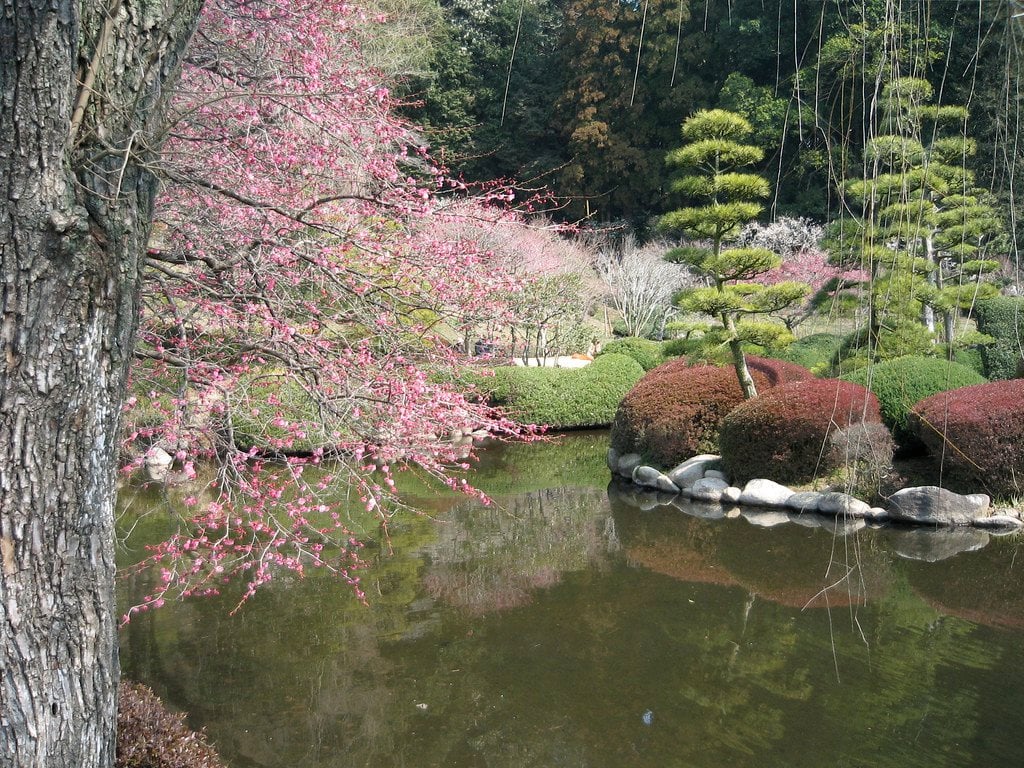
Kairakuen garden is a famous Japanese garden to see plum (ume) blossom in late winter and early spring. The word Kairakuen simply means “garden for everyone’s pleasure or park to be enjoyed together”.
It is located in Mito, Ibaraki Prefecture and is designated as one of the most three beautiful great gardens of Japan. I see this garden as the best landscape garden in all over Japan.
I have visited many Japanese gardens, I have to admit that every Japanese garden I had visited so far in my life was marvelous, but I have to put this one aside.
I would definitely tell you why I believe this is the best landscape garden of Japan. The reason is – I am a plum blossom aficionado, and I visit this garden when 3000 plum trees are in full bloom during early spring.
There are about 100 varieties of plum trees that create an extra flavor to this garden. Show your honor and gratitude to the lord Tokugawa Nariaki by taking a visit to this garden who built this beautiful garden for you in 1842.
Kenrokuen Garden:
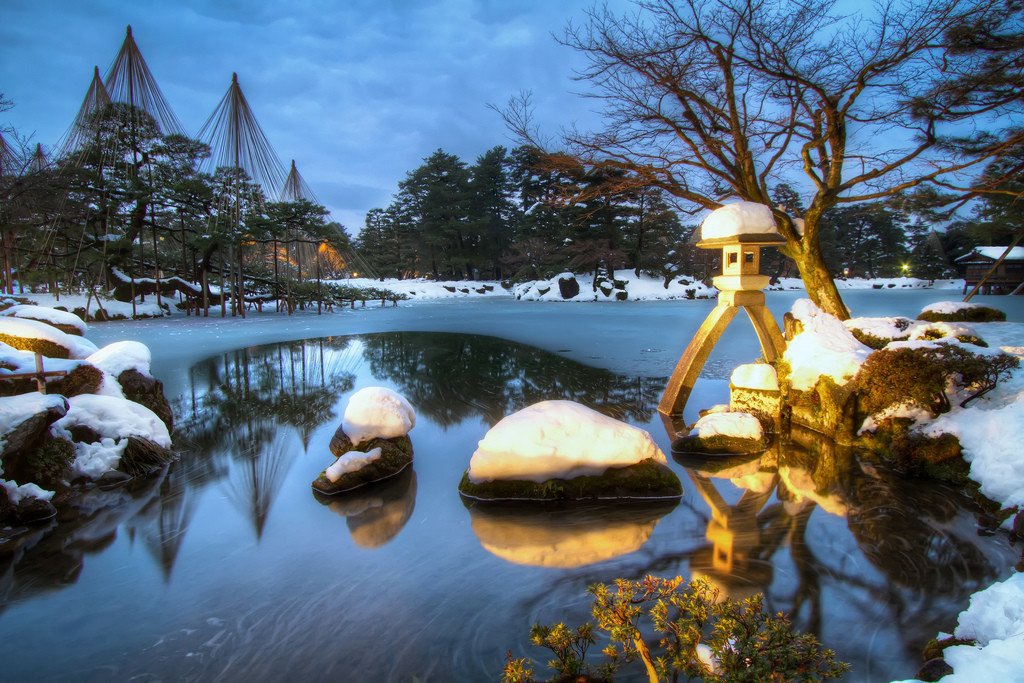
Located in Kanazawa city of Ishikawa Prefecture, Kenrokuen garden has been designated as a “Special Places of Scenic Beauty” by the Japanese Ministry of Education, Culture, Sports, Science and Technology under the Protection of Cultural Protection Act. Therefore, it deserves to be one of the three great gardens of Japan.
It was built by the feudal lords of Kaga. Kenrokuen is considered a strolling style private garden.
A big garden may consists of two or three types of Japanese gardens and real example for this fact is Kenrokuen. There are some areas in the garden, in which cherry blossoms can be seen in the spring.
If you plan on visiting Kanazawa Castle, don’t forget pay a visit there as it is located next to the castle’s grounds. This garden’s main elements are a big artificial pond, islands, rocks, teahouses, stone lantern, cottages, flower garden, moss, and strolling path.
In order to enjoy a glorious view of seasonal nature you have got to come here and enjoy your experiences.
List of the Most Famous Gardens you Could Visit in Japan

There are many Japanese gardens you can visit in Japan.
But to see some special feature such as autumn colors, cherry blossoms, irises, azaleas, plum blossoms, and bamboo forest in a single garden you have got to come here either in spring, summer, autumn and winter.
Below are the places where the best and most beautiful Japanese gardens are located.
1) Korakuen (Stroll Garden)
2) Kairakuen (Landscape Garden)
3) Kenrokuen (Stroll, Tea and Landscape Garden)
4) Ryoan-ji temple (Zen Garden)
5) Suizenji Koen (Stroll Garden)
6) Tenryu-ji temple (Stroll Garden)
7) Tofuku-ji temple (Zen Garden)
8) Entsu-ji temple (Landscape Garden)
9) Kinkakuji/Golden Pavilion (Stroll and Landscape Garden)
10) Katsura Imperial Villa (Pond and Stroll Garden)
11) Adachi Museum of Art (Japanese Modern Garden)
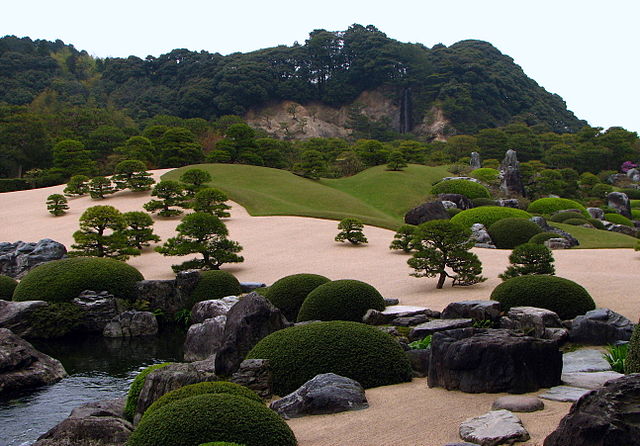
12) Ginkaku-ji (Pond and Dry garden)
13) Shoden-ji (Zen Garden)
14) Hosen-in (Zen Garden)
15) Byodoin (Paradise Garden)
16) Daitoku-ji Temple (Zen Garden)
17) Motsuji temple (Paradise Garden)
18) Suizenji Park (Stroll Garden)
19) Ginkaku-ji (Zen and Moss Garden)
20 Heijo Palace (Pond Garden)
21) Saiho-ji temple (Moss Garden)
22) Shukkeien Garden (Stroll and Hill Garden)
23) Daigoji Temple (Landscape and Zen Garden)
24) Ritsurin Garden (Stroll Garden)
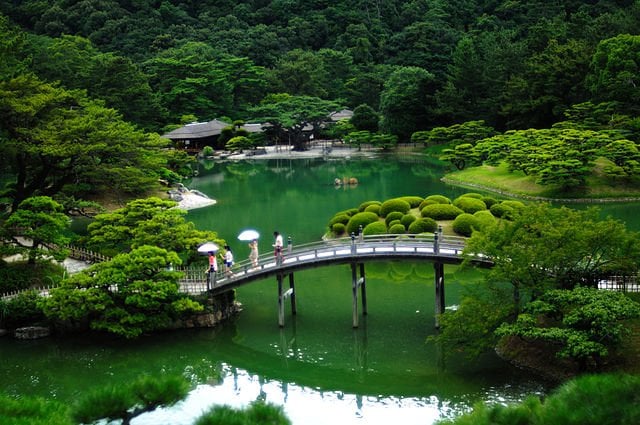
25) Nijo Castle (Landscape Garden)
26) Shikinaen Garden (Stroll Garden)
27) Kyoto Imperial Palace (Dry Garden)
28) Kanjizaio-in (Paradise Garden)
29) Shinjuku Gyoen (Landscape, English and French Garden)
30) Ninnaji Temple (Zen Garden)
31) Toji Temple (Zen and Pond Garden)
32) Oyama Shrine (Pond Garden)
33) Nanzenji Temple (Pond Garden)
34) Kodai-ji temple (Zen Garden)
35) Heian-Jingu Shrine (Pond Garden)
Four Seasons and the Japanese Gardens Beauty

The four seasons of Japan has a great impact on Japanese gardens. There are many people who usually take an evening stroll in various Japanese gardens in the spring, autumn and summer.
When it comes to early spring, one can enjoy his/her time viewing colorful ume blossoms in Kairkuen garden. In fact, early spring is the proper time to have a first outdoor picnic of year before hanami arrives.
There is a list of famous gardens in Japan that host hanami matsuri in the spring. At that time of year, people go out to view and admire the beauty of cherry blossoms and most of the famous Sakura viewing spots are located in public parks, gardens, temples & shrines, castle ground, and riverbanks.
For example, you could head towards Ninnaji temple which is considered to be one of the best Sakura viewing spots in Kyoto.

It is just lovely to see that the famous Japanese gardens come alive when autumn season arrives. Colorful fall foliage creates a great atmosphere to have a stroll on day time.
In order to see a lovely Zen garden in Kyoto, you can get to Tofuku-ji temple, especially when autumn foliage shines its temple grounds.
If it is summer now, I would definitely tell you to attend some iris festivals, take place at various Japanese gardens across the country.
In general, Iris festival is held in summer. If you have to experience both iris flower and Japanese garden, make a travel plan to start your expedition.
Let’s just say, there is a large segment of the flower loving population in Japan and I personally think that I am one of them. So, Japan’s summer humid weather can’t resist me to see irises.
Japanese winter season does not make you to stay inside your home only, rather it is very magical time of year offering you various exciting outdoor winter activities.
There are some visitors who tend to visit Japanese gardens in winter; I think they want to see their (gardens) winter beauty even when it snows a lot.
I know you will come here all the way from different countries and Japanese gardens actually are well prepared to make you happy anytime you visit them throughout the year.
Japanese Garden Impact on Japanese Culture

Japanese culture is rich enough to make someone curious of it. It is believed that creating/designing a garden is a special form of art in Japanese culture that rank is equal to calligraphy and ink painting. I reckon you have seen Japanese garden in various paintings created by Japanese artists.
Tensho Shubun was a Japanese Zen monk and a great painter of the Muromachi era. He had painted a well known painting called “Landscape of the Four Seasons.”
That painting represents a lot of things about nature and Japanese landscape. A lot of modern Japanese artists depict the Japanese garden beauty in their artworks.
You can find beautiful Japanese gardens in the classic Japanese novel from Heian period called “Tale of Genji”. In fact, those writers who fell in love with the beauty of Japanese garden and knew its value – they all described it at least once in their literature.
In modern Japan, people still show their gratitude visiting profound gardens. They sometimes even make an outdoor picnic party especially during the springtime.
It would not have been possible if we had not had those Japanese gardens. We really are thankful to those who built all these magnificent gardens. Really, we are proud of them!
Would you Like to Visit a Japanese Garden in Japan?

What do you think, after reading this post? Would you like to visit one of the best Japanese gardens listed above? I think, you certainly would like to visit them all, but your time would not let you do that.
I advise you to pick some of them which are located not far from each other. It would be great if you head to Kyoto where most of the beautiful Japanese gardens are situated.
If you ask me about “what’s the best time to visit a Japanese garden?” The easy answer would be “At anytime of year.” Every season makes a Japanese garden fully attractive and unique place to discover.
If you are inspired by this post and want make a simple Japanese garden on your own, then I recommend this great book called “Creating Your Own Japanese Garden” – by Takashi Sawano.
If Japanese gardens don’t excite you, then you are not alive. Just kidding with you guys! In fact, they ought to excite you for sure.
I hope you enjoy the four seasons of Japan in different Japanese gardens where thousands years of history come alive.

